Here are the Code examples of this chapter. You can compile them online right on this web page by pressing the Typeset / Compile button. You can also edit them for testing, and compile again.
For a better view with the online compiler, I sometimes use \documentclass[border=10pt]{standalone} instead of \documentclass{article}. Instead of having a big letter/A4 page, the standalone class crops the paper to see just the visible text without an empty rest of a page.
Any question about a code example? Post it on LaTeX.org, I will answer. As forum admin I read every single question there. (profile link).
Example document
\documentclass[preview,border=10pt]{standalone}
\begin{document}
\section*{Quadratic equations}
The quadratic equation
\begin{equation}
\label{quad}
ax^2 + bx + c = 0,
\end{equation}
where \( a, b \) and \( c \) are constants and \( a \neq 0 \),
has two solutions for the variable \( x \):
\begin{equation}
\label{root}
x_{1,2} = \frac{-b \pm \sqrt{b^2-4ac}}{2a}.
\end{equation}
If the \emph{discriminant} \( \Delta \) with
\[
\Delta = b^2 - 4ac
\]
is zero, then the equation (\ref{quad}) has a double solution:
(\ref{root}) becomes
\[
x = - \frac{b}{2a}.
\]
\end{document}

Figure 9.1
Subscripts and superscripts
\documentclass[preview,border=10pt]{standalone}
\begin{document}
\[
x_1^2 + x_2^2 = 1, \quad 2^{2^x} = 64
\]
\end{document}

Figure 9.2
Operators
\documentclass[preview,border=10pt]{standalone}
\begin{document}
\[
\lim_{n=1, 2, \ldots} a_n \qquad \max_{x<X} x
\]
\end{document}

Figure 9.3
Operators within text
\documentclass[preview,border=10pt]{standalone}
\begin{document}
Within text, we have \( \lim_{n=1, 2, \ldots} a_n \)
and \( \max_{x<X} x \).
\end{document}

Figure 9.4
Roots
\documentclass[preview,border=10pt]{standalone}
\begin{document}
\[
\sqrt[64]{x} = \sqrt{\sqrt{\sqrt{\sqrt{\sqrt{\sqrt{x}}}}}}
\]
\end{document}
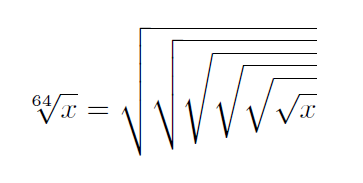
Figure 9.5
Fractions
\documentclass[preview,border=10pt]{standalone}
\begin{document}
\[
\frac{n(n+1)}{2} \quad \frac{\frac{\sqrt{x}+1}{2}-x}{y^2}
\]
\end{document}
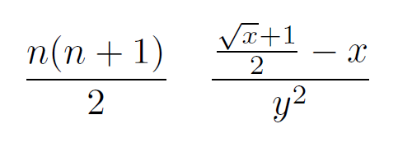
Figure 9.6
Greek letters
\documentclass[border=10pt]{standalone}
\newcommand*\s[1]{$#1$&\texttt{\string#1}}
\setlength{\tabcolsep}{2ex}
\begin{document}
\begin{tabular}{l@{~}ll@{~}ll@{~}ll@{~}ll@{~}l}
\s\alpha & \s\zeta & \s\lambda & \s\pi & \s\phi \\
\s\beta & \s\eta & \s\mu & \s\rho &\s\chi \\
\s\gamma & \s\theta & \s\nu & \s\sigma &\s\psi\\
\s\delta & \s\iota & \s\xi & \s\tau &\s\omega \\
\s\epsilon & \s\kappa & \s o & \s\upsilon&
\end{tabular}
\end{document}

Figure 9.7
Variants of Greek letters
\documentclass[border=10pt]{standalone}
\newcommand*\s[1]{$#1$&\texttt{\string#1}}
\setlength{\tabcolsep}{2ex}
\begin{document}
\begin{tabular}{l@{~}ll@{~}ll@{~}l}
\s\varepsilon & \s\varpi & \s\varsigma \\
\s\vartheta & \s\varrho & \s\varphi
\end{tabular}
\end{document}

Figure 9.8
Uppercase Greek letters
\documentclass[border=10pt]{standalone}
\newcommand*\s[1]{$#1$&\texttt{\string#1}}
\setlength{\tabcolsep}{2ex}
\begin{document}
\begin{tabular}{l@{~}ll@{~}ll@{~}ll@{~}l}
\s\Gamma &\s\Lambda &\s\Sigma &\s\Psi \\
\s\Delta &\s\Xi &\s\Upsilon &\s\Omega \\
\s\Theta &\s\Pi &\s\Phi
\end{tabular}
\end{document}

Figure 9.9
Upright Greek letters
\documentclass[border=10pt]{standalone}
\usepackage{upgreek}
\newcommand*\s[1]{$#1$&\texttt{\string#1}}
\setlength{\tabcolsep}{2ex}
\begin{document}
\thispagestyle{empty}
\begin{tabular}{l@{~}ll@{~}ll@{~}ll@{~}ll@{~}l}
\s\upalpha & \s\upzeta & \s\uplambda & \s\uppi & \s\upphi \\
\s\upbeta & \s\upeta & \s\upmu & \s\uprho &\s\upchi \\
\s\upgamma & \s\uptheta & \s\upnu & \s\upsigma &\s\uppsi\\
\s\updelta & \s\upiota & \s\upxi & \s\uptau &\s\upomega \\
\s\upepsilon & \s\upkappa & $\mathrm{o}$&\texttt{\string\mathrm\{o\}} & \s\upupsilon&
\end{tabular}
\end{document}

Figure 9.11
Variants of upright Greek letters
\documentclass[border=10pt]{standalone}
\usepackage{upgreek}
\newcommand*\s[1]{$#1$&\texttt{\string#1}}
\setlength{\tabcolsep}{2ex}
\begin{document}
\begin{tabular}{l@{~}ll@{~}ll@{~}l}
\s\upvarepsilon & \s\upvarpi & \s\upvarsigma \\
\s\upvartheta & \s\upvarrho & \s\upvarphi
\end{tabular}
\end{document}

Figure 9.11
Script letters
\documentclass[preview,border=10pt]{standalone}
\begin{document}
\[
\mathcal{A}, \mathcal{B}, \mathcal{C}, \ldots, \mathcal{Z}
\]
\end{document}

Figure 9.12
Ellipsis
\documentclass[border=10pt]{standalone}
\newcommand*\s[1]{\(#1\)&\texttt{\string#1}}
\setlength{\tabcolsep}{1.8ex}
\begin{document}
\centering
\begin{tabular}{*3{c@{~}l}}
\s\ldots & \s\ddots \\
\s\cdots & \s\vdots \\
\end{tabular}
\end{document}
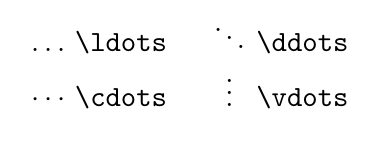
Figure 9.13
Math font styles
\documentclass[border=10pt]{standalone}
\usepackage{booktabs}
\usepackage{amsfonts}
\usepackage{bbm}
\usepackage{dsfont}
\usepackage{eufrak}
\renewcommand*\c{\textbackslash\ttfamily}
\begin{document}
\sffamily
\begin{tabular}{lll}
\toprule
\textbf{Command} & \textbf{Used package} & \textbf{Example} \\
\midrule
\c mathrm\{\ldots\} & & \(\mathrm{roman\ 123}\) \\
\c mathit\{\ldots\} & & \(\mathit{italic\ 123}\) \\
\c mathsf\{\ldots\} & & \(\mathsf{sans-serif\ 123}\) \\
\c mathbb\{\ldots\} & amsfonts & \(\mathbb{ABC}\) \\
\c mathbbm\{\ldots\} & bbm & \(\mathbbm{C R Q Z 1}\) \\
\c mathds\{\ldots\} & dsfont &\(\mathds{C R Q Z 1}\) \\
\c mathfrak\{\ldots\} & eufrak & \(\mathfrak{A B C \ 1 2 3}\) \\
\c mathnormal\{\ldots\} & & \(\mathnormal{normal}\) \\
\bottomrule
\end{tabular}
\end{document}
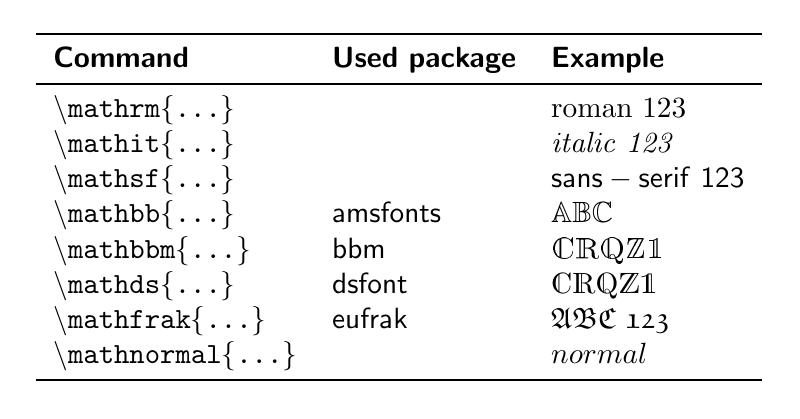
Figure 9.14
Math versus text italic
\documentclass[border=10pt]{standalone}
\begin{document}
\(Definition\) and \textit{Definition}
\end{document}

Figure 9.15
Typesetting multi-line formulas
\documentclass[preview,border=10pt]{standalone}
\usepackage{amsmath}
\begin{document}
\begin{multline}
\sum = a + b + c + d + e \\
+ f + g + h + i + j \\
+ k + l + m + n
\end{multline}
\begin{gather}
x + y + z = 0 \\
y - z = 1
\end{gather}
\begin{align}
x + y + z &= 0 \\
y - z &= 1
\end{align}
\end{document}

Figure 9.16

Figure 9.17

Figure 9.18
Customized tagging
\documentclass[preview,border=10pt]{standalone}
\usepackage{amsmath}
\begin{document}
\begin{align}
x + y + z &= 0 \tag{$\star$} \\
y - z &= 1 \tag{$\star\star$}
\end{align}
\end{document}
Binary operation symbols
\documentclass[border=10pt]{standalone}
\newcommand*\s[1]{\(#1\)&\texttt{\string#1}}
\setlength{\tabcolsep}{1ex}
\usepackage{booktabs}
\usepackage{latexsym}
\begin{document}
\sffamily
\centering
\begin{tabular}{*4{c@{~}l}}
\toprule
\multicolumn{8}{c}{\bfseries Standard \LaTeX} \\
\s\amalg & \s\circ & \s\ominus & \s\star \\
\s\ast & \s\cup & \s\oplus & \s\times \\
\s\bigcirc & \s\dagger & \s\oslash & \s\triangleleft\\
\s\bigtriangledown & \s\ddagger & \s\otimes & \s\triangleright \\
\s\bigtriangleup & \s\diamond & \s\pm & \s\uplus \\
\s\bullet & \s\div & \s\setminus & \s\vee \\
\s\cap & \s\mp & \s\sqcap & \s\wedge \\
\s\cdot & \s\odot & \s\sqcup & \s\wr \\
\midrule
\multicolumn{8}{c}{\bfseries latexsym }\\
\s\unlhd & \s\unrhd & \s\rhd & \s\lhd \\
\bottomrule
\end{tabular}
\end{document}

Figure 9.19
Binary relation symbols
\documentclass[border=10pt]{standalone}
\newcommand*\s[1]{\(#1\)&\texttt{\string#1}}
\setlength{\tabcolsep}{1.8ex}
\usepackage{booktabs}
\usepackage{latexsym}
\begin{document}
\begin{tabular}{*4{c@{~}l}}
\toprule
\multicolumn{8}{c}{\bfseries Standard \LaTeX} \\
\s\approx & \s\equiv & \s\prec & \s\succ \\
\s\asymp & \s\frown & \s\preceq & \s\succeq \\
\s\bowtie & \s\mid & \s\propto & \s\vdash \\
\s\cong & \s\models & \s\sim & \\
\s\dashv & \s\parallel & \s\simeq \\
\s\doteq & \s\perp & \s\smile \\
\midrule
\multicolumn{8}{c}{\bfseries latexsym }\\
\multicolumn{8}{c}{\(\Join\) ~ \texttt{\string\Join}} \\
\bottomrule
\end{tabular}
\end{document}

Figure 9.20
Inequality relation symbols
\documentclass[border=10pt]{standalone}
\newcommand*\s[1]{\(#1\)&\texttt{\string#1}}
\setlength{\tabcolsep}{1.8ex}
\usepackage{booktabs}
\begin{document}
\sffamily
\centering
\begin{tabular}{*5{c@{~}l}}
\toprule
\s\geq & \s\gg & \s\leq & \s\ll & \s\neq \\
\bottomrule
\end{tabular}
\end{document}

Figure 9.21
Subset and superset symbols
\documentclass[border=10pt]{standalone}
\newcommand*\s[1]{\(#1\)&\texttt{\string#1}}
\setlength{\tabcolsep}{1.8ex}
\usepackage{booktabs}
\usepackage{latexsym}
\begin{document}
\sffamily
\centering
\begin{tabular}{*3{c@{~}l}}
\toprule
\multicolumn{6}{c}{\bfseries Standard \LaTeX} \\
\s\sqsubseteq & \s\subset & \s\supset \\
\s\sqsupseteq & \s\subseteq & \s\supseteq \\
\midrule
\multicolumn{6}{c}{\bfseries latexsym }\\
\multicolumn{3}{c}{\(\sqsubset\) ~ \texttt{\string\sqsubset}}
& \multicolumn{3}{c}{\(\sqsupset\) ~ \texttt{\string\sqsupset}}\\
\bottomrule
\end{tabular}
\end{document}
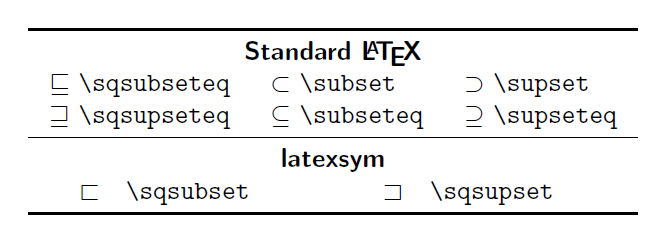
Figure 9.22
Arrows
\documentclass[border=10pt]{standalone}
\newcommand*\s[1]{\(#1\)&\texttt{\string#1}}
\setlength{\tabcolsep}{1.8ex}
\usepackage{booktabs}
\usepackage{latexsym}
\begin{document}
\sffamily
\centering
\begin{tabular}{*3{c@{~}l}}
\toprule
\multicolumn{6}{c}{\bfseries Standard \LaTeX} \\
\s\downarrow & \s\Longleftarrow & \s\Rightarrow \\
\s\Downarrow & \s\longleftrightarrow & \s\searrow \\
\s\hookleftarrow & \s\Longleftrightarrow & \s\swarrow \\
\s\hookrightarrow & \s\longmapsto & \s\uparrow \\
\s\leftarrow & \s\longrightarrow & \s\Uparrow \\
\s\Leftarrow & \s\Longrightarrow & \s\updownarrow \\
\s\leftrightarrow & \s\mapsto & \s\Updownarrow \\
\s\Leftrightarrow & \s\nwarrow \\
\s\longleftarrow & \s\rightarrow \\
\midrule
\multicolumn{6}{c}{\bfseries latexsym }\\
\multicolumn{6}{c}{\(\leadsto\) ~ \texttt{\string\leadsto}}\\
\bottomrule
\end{tabular}
\end{document}
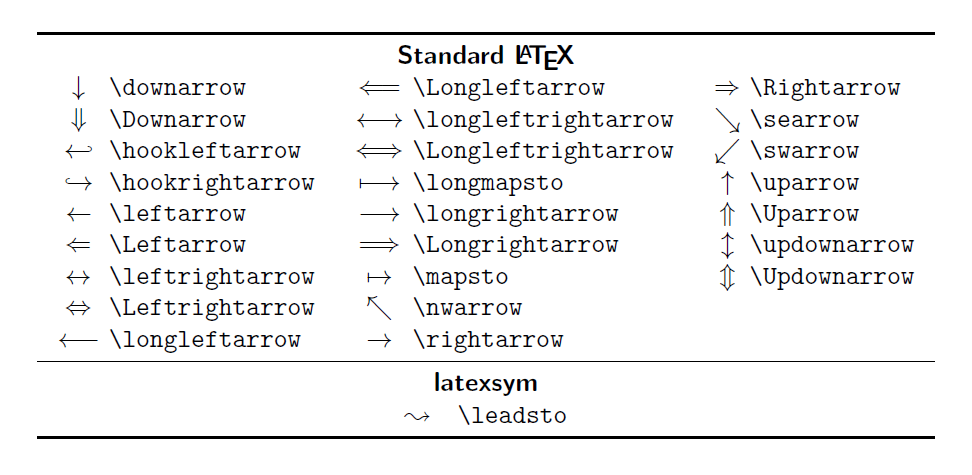
Figure 9.23
Harpoons
\documentclass[border=10pt]{standalone}
\newcommand*\s[1]{\(#1\)&\texttt{\string#1}}
\setlength{\tabcolsep}{1.8ex}
\usepackage{booktabs}
\begin{document}
\sffamily
\centering
\begin{tabular}{*3{c@{~}l}}
%\toprule
\s\leftharpoondown & \s\rightharpoondown & \s\rightleftharpoons \\
\s\leftharpoonup & \s\rightharpoonup \\
%\bottomrule
\end{tabular}
\end{document}

Figure 9.24
Symbols dereived from letters
\documentclass[border=10pt]{standalone}
\newcommand*\s[1]{\(#1\)&\texttt{\string#1}}
\setlength{\tabcolsep}{1.8ex}
\usepackage{booktabs}
\usepackage{latexsym}
\begin{document}
\sffamily
\centering
\begin{tabular}{*5{c@{~}l}}
\toprule
\multicolumn{10}{c}{\bfseries Standard \LaTeX} \\
\s\bot & \s\forall & \s\imath & \s\ni & \s\top \\
\s\ell & \s\hbar & \s\in & \s\partial & \s\wp \\
\s\exists & \s\Im & \s\jmath & \s\Re \\
\midrule
\multicolumn{10}{c}{\bfseries latexsym }\\
\multicolumn{10}{c}{\(\mho\) ~ \texttt{\string\mho}}\\
\bottomrule
\end{tabular}
\end{document}
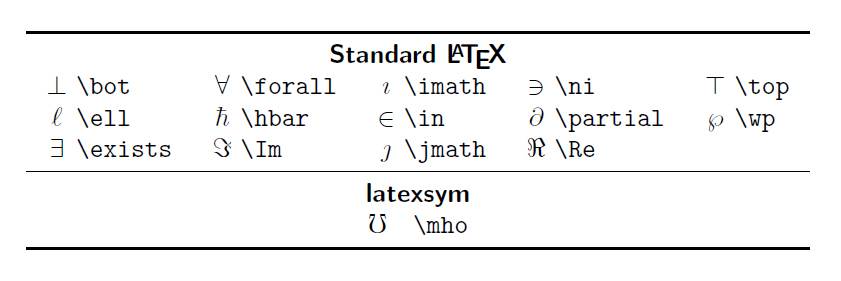
Figure 9.25
Misc symbols
\documentclass[border=10pt]{standalone}
\newcommand*\s[1]{\(#1\)&\texttt{\string#1}}
\setlength{\tabcolsep}{1.8ex}
\usepackage{booktabs}
\usepackage{latexsym}
\begin{document}
\sffamily
\centering
\begin{tabular}{*4{c@{~}l}}
\toprule
\multicolumn{8}{c}{\bfseries Standard \LaTeX }\\
\s\aleph & \s\emptyset & \s\nabla & \s\sharp \\
\s\angle & \s\flat &\s\natural & \s\spadesuit \\
\s\clubsuit & \s\heartsuit & \s\neg & \s\surd \\
\s\diamondsuit & \s\infty &\s\prime & \s\triangle \\
\midrule
\multicolumn{8}{c}{\bfseries latexsym}\\
\multicolumn{4}{c}{\(\Box\) ~ \texttt{\string\Box}}
& \multicolumn{4}{c}{\(\Diamond\) ~ \texttt{\string\Diamond}}\\
\bottomrule
\end{tabular}
\end{document}
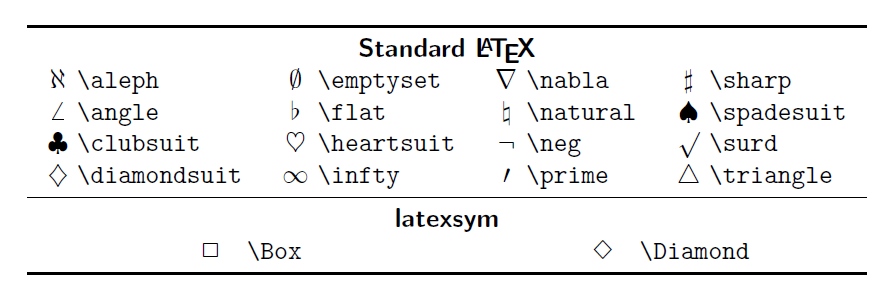
Figure 9.26
Variable sized operators
\documentclass[border=10pt]{standalone}
\newcommand*\s[1]{$\displaystyle#1$&\texttt{\string#1}}
\renewcommand*\arraystretch{1.8}
\setlength{\arraycolsep}{3ex}
\begin{document}
\begin{tabular}{*4{c@{~}l}}
\s\bigcap & \s\bigotimes & \s\bigwedge & \s\prod \\
\s\bigcup & \s\bigsqcup & \s\coprod & \s\sum \\
\s\bigodot & \s\biguplus & \s\int \\
\s\bigoplus & \s\bigvee & \s\oint \\
\end{tabular}
\end{document}
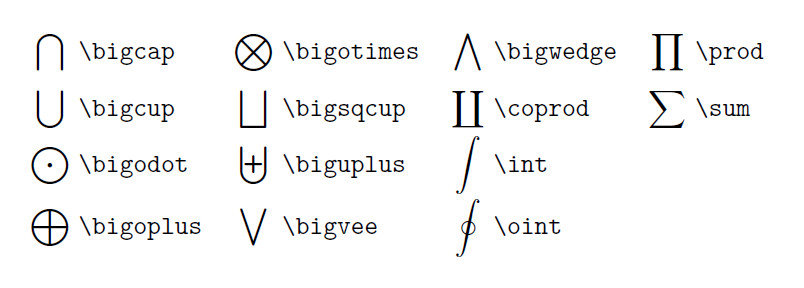
Figure 9.29
Inline text equation
\documentclass[border=10pt]{standalone}
\usepackage{amsmath}
\begin{document}
\(
\int_a^b \! f(x) \, dx = \lim_{\Delta x \rightarrow 0}
\sum_{i=1}^{n} f(x_i) \,\Delta x_i
\)
\end{document}

Figure 9.30
Displayed style equation
\documentclass[preview,border=10pt]{standalone}
\usepackage{amsmath}
\begin{document}
\[
\int_a^b \! f(x) \, dx = \lim_{\Delta x \rightarrow 0}
\sum_{i=1}^{n} f(x_i) \,\Delta x_i
\]
\end{document}

Figure 9.31
Variable sized delimiters
\documentclass[border=10pt]{standalone}
\newcommand*\s[1]{$\displaystyle\Big#1$&\texttt{\string#1}}
\renewcommand*\arraystretch{1.8}
\setlength{\tabcolsep}{2ex}
\usepackage{booktabs}
\begin{document}
\begin{tabular}{*3{c@{\quad}l}}
\toprule
\multicolumn{6}{c}{\bfseries Pairs of braces, brackets and parentheses} \\
\(\Big(\ \Big)\) & \verb|( )| & \(\Big\{\ \Big\}\) & \verb|\{ \}| & \(\Big\lceil\ \Big\rceil\) & \verb|\lceil \rceil|\\
\({\Big[\ \Big]}\) & \verb|[ ]| & \(\Big\langle\ \Big\rangle\) & \verb|\langle \rangle|& \(\Big\lfloor\ \Big\rfloor\) & \verb|\lfloor \rfloor| \\
\midrule
\multicolumn{6}{c}{\bfseries Delimiting symbols and arrows}\\
\s/ & \s\downarrow & \s\updownarrow \\
\s\backslash & \s\Downarrow & \s\Updownarrow\\
\s| & \s\uparrow \\
\s\| & \s\Uparrow \\
%\s\unlhd & \s\unrhd & \s\rhd & \s\lhd \\
\bottomrule
\end{tabular}
\end{document}
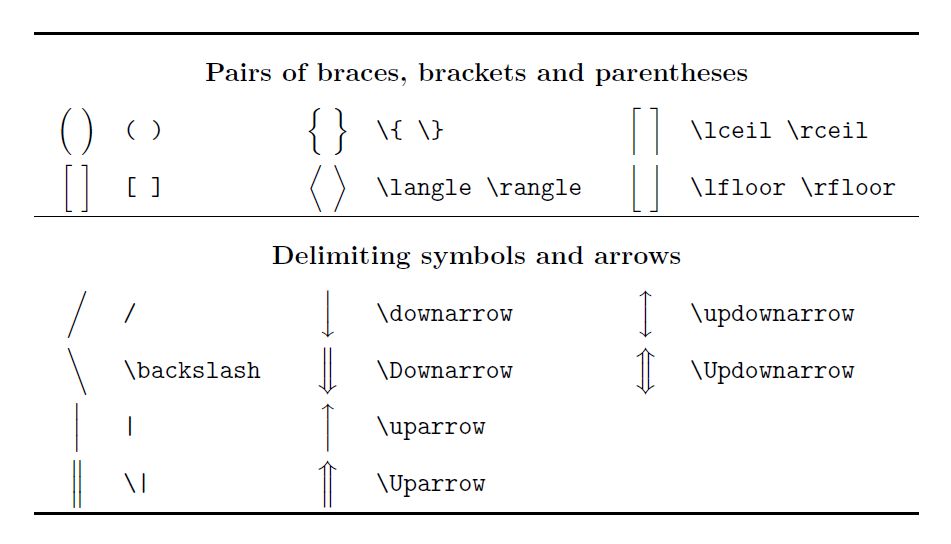
Figure 9.32
Arrays
\documentclass[preview,border=10pt]{standalone}
\usepackage{amsmath}
\begin{document}
\[
A = \left(
\begin{array}{cc}
a_{11} & a_{12} \\
a_{21} & a_{22}
\end{array}
\right)
\]
\end{document}
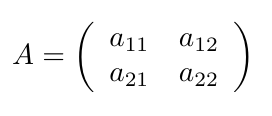
Figure 9.33
Typesetting matrices
\documentclass[preview,border=10pt]{standalone}
\usepackage{amsmath}
\begin{document}
\[
A = \begin{pmatrix}
a_{11} & a_{12} \\
a_{21} & a_{22}
\end{pmatrix}
\]
\end{document}
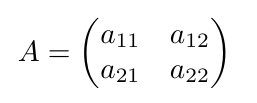
Figure 9.34
Writing binomial coefficients
\documentclass[preview,border=10pt]{standalone}
\usepackage{amsmath}
\begin{document}
\[
\binom{n}{k} = \frac{n!}{k!(n-k)!}
\]
\end{document}
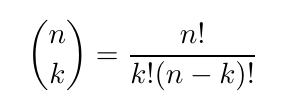
Figure 9.35
Underlining and overlining
\documentclass[preview,border=10pt]{standalone}
\usepackage{amsmath}
\begin{document}
\[
\overline{\Omega}
\]
\end{document}

Figure 9.36
An underbrace below an expression
\documentclass[preview,border=10pt]{standalone}
\usepackage{amsmath}
\begin{document}
\[
N = \underbrace{1 + 1 + \cdots + 1}_n
\]
\end{document}

Figure 9.37
Accents
\documentclass[border=10pt]{standalone}
\setlength{\tabcolsep}{1.8ex}
\usepackage{array}
\usepackage{booktabs}
\begin{document}
\sffamily
\centering
\begin{tabular}{*4{>{$}c<{$}@{~}l}}
\toprule
\acute{a} & \verb|\acute{a}| &\check{a} & \verb|\check{a}| &\grave{a} & \verb|\grave{a}| &\tilde{a} & \verb|\tilde{a}| \\
\bar{a} & \verb|\bar{a}| & \ddot{a} & \verb|\ddot{a}| & \hat{a} & \verb|\hat{a}| & \vec{a} & \verb|\vec{a}| \\
\breve{a} & \verb|\breve{a}| & \dot{a} & \verb|\dot{a}| & \mathring{a} & \verb|\mathring{a}| \\
\midrule
\multicolumn{8}{c}{\textbf{Extensible}} \\
\multicolumn{4}{c}{$\widehat{abc}$\,\ \texttt{\string\widehat\{abc\}}} & \multicolumn{4}{c}{$\widetilde{abc}$\,\ \texttt{\string\widetilde\{abc\}}}\\
\bottomrule
\end{tabular}
\end{document}

Figure 9.38
Putting a symbol above or below another one
\documentclass[preview,border=10pt]{standalone}
\usepackage{amsmath}
\begin{document}
\[
\underset{\circ}{\cap} \neq \overset{\circ}{\cup}
\]
\end{document}

Figure 9.39
Text above a relation symbol
\documentclass[preview,border=10pt]{standalone}
\usepackage{amsmath}
\begin{document}
\[
X \stackrel{\text{def}}{=} 0
\]
\end{document}

Figure 9.40
Writing theorems and definitions
\documentclass[preview,border=10pt]{standalone}
\usepackage{amsmath}
\newtheorem{thm}{Theorem}
\newtheorem{dfn}[thm]{Definition}
\begin{document}
\begin{dfn}
A quadratic equation is an equation of the form
\begin{equation}
\label{quad}
ax^2 + bx + c = 0,
\end{equation}
where \( a, b \) and \( c \) are constants and \( a \neq 0 \).
\end{dfn}
\begin{thm}
A quadratic equation (\ref{quad}) has two solutions for the
Variable \( x \):
\begin{equation}
\label{root}
x_{1,2} = \frac{-b \pm \sqrt{b^2-4ac}}{2a}.
\end{equation}
\end{thm}
\end{document}
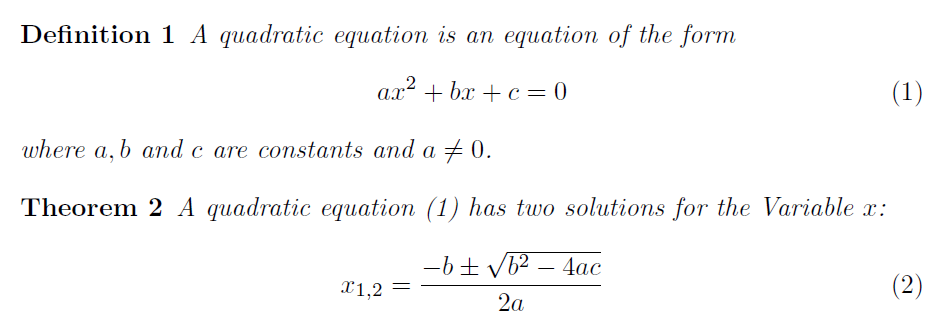
Figure 9.41
This code is available on Github. It is licensed under the MIT License, a short and simple permissive license with conditions only requiring preservation of copyright and license notices.
Go to next chapter.